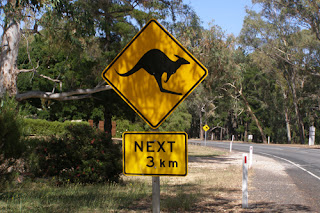Jacob’s Creek Leads the Way to Barossa
Greg Stirling, Head of Brand Sites & Visitations for Orlando Wines, a division of Pernod Ricard, picked me up in Adelaide for the scenic drive up to the Barossa Valley in South Australia. It is one of the country’s top wine regions and home to his biggest brand – Jacob’s Creek.
I had spent some time with Jacob’s Creek (the wine and the people who make it) during the Australian Open, but this was my first visit to the winery and grounds. It began with a bit of history on my way up about Johan Jacob, the pioneer that purchased this land over 200 years ago. Greg also explained to me about the area, Roland Flat, which is also the translation of Jacob’s son, Orlando. It would be “Orlando Wines” that Jacob’s Creek was launched under in 1976, before Pernod Ricard would buy the brand.
The land was hilly with brown grass in between that showed signs of the dry summer, but it didn’t make the valley look any more beautiful. It was an area where kangaroos and emus run free, as the signs make you aware of throughout the drive. It was hard to believe this was just an hour from the city of Adelaide, which is just an hour’s plane ride from Melbourne. Jacob’s Creek has been continually voted the best major tourist attraction in this part of Australia. Though tours are mostly be appointment, the tastings, movies on the lawns, trails and animal enclosure are all open to the public every day except Good Friday and Christmas.
Jacob’s Creek produces the typical varieties of the area, including Chardonnay, Riesling and Shiraz, but they are continually experimenting with planting lesser known grapes, like the Spanish Graciano, or Lagraein, known as Dolcetto in Northern Italy. Chief Winemaker Bernard Hickin also enjoys blending to make his own creations, such as the Three Vines selection, which includes a white (Semillon, Sauvignon Blanc, Viognier), a freshly tropical wine full of grapefruit and a bit of apricot; Rose (Shiraz, Grenach, Sangiovese), a bit dryer, but light an fruity in the European style; and Red (Shiraz, Grenache, Tempranillo), complex and full of black berry with a bit of cinnamon and nutmeg.
Before I got to the blends, I went through the Jacob’s Creek standards with Winemaker Hickin. We started with the Moscatos, first introduced in 2009 with the Sparkling and then expanded with the still wines last year. The Jacob’s Creek Sparkling Moscato was full of pear, peach and kiwi, with a hint of honeysuckle. Very sweet and tropical – a perfect summer drink. I loved the Moscato Rose, full of red fruit like cherry and raspberry and a bit of sparkle. The Jacob’s Creek Moscato 2010 was very light a little more citrusy than the others. It was also not quite as sweet and though not sparkling, it had a bit of fizz.
Jacob’s Creek Pinot Grigio is a combination of fruit and mineral, with some apple, pear and citrus notes. It’s drier than the Pinot Grigio most often seen in the U.S., but, according to Hickin, that makes it easier to pair with food, as is my first introduction to Jacob’s Creek, the Riesling. For a fruity, floral blend, full of rose petals and citrus, try the 2010, an excellent year for this grape. Jacob’s Creek also released a Reserve Barossa Dry Riesling that year. It was a bit too dry for me, however, that’s not the case for everyone – it’s the biggest seller for the company in the United Kingdom.
I was very pleasantly surprised with Jacob’s Creek Chardonnay, a wine I don’t usually count as one of my favorites. The 2010 was given a bit less oak than most Chardonnays, leaving it with more melon and citrus than spice. For those who do like the more oaky Chardonnay, I’d recommend the Reserve Adelaide Hills Chardonnay, an area that also produced a terrific Pinot Noir, with lots of black cherry, as well as spicy vanilla and cinnamon.
I had my first Australian Merlot at Jacob’s Creek and it was quite a good one, with very light spice, dark cherry, blueberry and blackberry. The soft tannins kept it more spice forward and fruit backward. The Cabernet Sauvignon (2009) had more mild flavors, including black currant, but was fruitier in the finish since the grapes were picked when very ripe. For a drier Cabernet, the Coonawarra, from a cooler region, works well. And, of course, Australian Shiraz is prevalent at this winery, with its meat friendly spice and long finish.
One interesting note about Jacob’s Creek is that they use screw caps on all their wines. There are a number of reasons for this, including the difficulty in getting good cork in Australia and the need to produce predictable, consistent wines. We enjoyed another of the company’s offerings, Steingarten Riesling, during a delicious lunch at the Jacob’s Creek Visitor’s Center, where it is definitely worth planning a meal. Then it was off to see where the Steingarten vineyards on a beautiful drive up to the highest (and coolest) grape growing area in the valley, before I headed to the Novotel Barossa and got ready to meet Jaci Thorne, Regional Tourism Manager Barossa Tourism, who would tell me about the rest of my schedule in the valley.
I had spent some time with Jacob’s Creek (the wine and the people who make it) during the Australian Open, but this was my first visit to the winery and grounds. It began with a bit of history on my way up about Johan Jacob, the pioneer that purchased this land over 200 years ago. Greg also explained to me about the area, Roland Flat, which is also the translation of Jacob’s son, Orlando. It would be “Orlando Wines” that Jacob’s Creek was launched under in 1976, before Pernod Ricard would buy the brand.
The land was hilly with brown grass in between that showed signs of the dry summer, but it didn’t make the valley look any more beautiful. It was an area where kangaroos and emus run free, as the signs make you aware of throughout the drive. It was hard to believe this was just an hour from the city of Adelaide, which is just an hour’s plane ride from Melbourne. Jacob’s Creek has been continually voted the best major tourist attraction in this part of Australia. Though tours are mostly be appointment, the tastings, movies on the lawns, trails and animal enclosure are all open to the public every day except Good Friday and Christmas.
Jacob’s Creek produces the typical varieties of the area, including Chardonnay, Riesling and Shiraz, but they are continually experimenting with planting lesser known grapes, like the Spanish Graciano, or Lagraein, known as Dolcetto in Northern Italy. Chief Winemaker Bernard Hickin also enjoys blending to make his own creations, such as the Three Vines selection, which includes a white (Semillon, Sauvignon Blanc, Viognier), a freshly tropical wine full of grapefruit and a bit of apricot; Rose (Shiraz, Grenach, Sangiovese), a bit dryer, but light an fruity in the European style; and Red (Shiraz, Grenache, Tempranillo), complex and full of black berry with a bit of cinnamon and nutmeg.
Before I got to the blends, I went through the Jacob’s Creek standards with Winemaker Hickin. We started with the Moscatos, first introduced in 2009 with the Sparkling and then expanded with the still wines last year. The Jacob’s Creek Sparkling Moscato was full of pear, peach and kiwi, with a hint of honeysuckle. Very sweet and tropical – a perfect summer drink. I loved the Moscato Rose, full of red fruit like cherry and raspberry and a bit of sparkle. The Jacob’s Creek Moscato 2010 was very light a little more citrusy than the others. It was also not quite as sweet and though not sparkling, it had a bit of fizz.
Jacob’s Creek Pinot Grigio is a combination of fruit and mineral, with some apple, pear and citrus notes. It’s drier than the Pinot Grigio most often seen in the U.S., but, according to Hickin, that makes it easier to pair with food, as is my first introduction to Jacob’s Creek, the Riesling. For a fruity, floral blend, full of rose petals and citrus, try the 2010, an excellent year for this grape. Jacob’s Creek also released a Reserve Barossa Dry Riesling that year. It was a bit too dry for me, however, that’s not the case for everyone – it’s the biggest seller for the company in the United Kingdom.
I was very pleasantly surprised with Jacob’s Creek Chardonnay, a wine I don’t usually count as one of my favorites. The 2010 was given a bit less oak than most Chardonnays, leaving it with more melon and citrus than spice. For those who do like the more oaky Chardonnay, I’d recommend the Reserve Adelaide Hills Chardonnay, an area that also produced a terrific Pinot Noir, with lots of black cherry, as well as spicy vanilla and cinnamon.
I had my first Australian Merlot at Jacob’s Creek and it was quite a good one, with very light spice, dark cherry, blueberry and blackberry. The soft tannins kept it more spice forward and fruit backward. The Cabernet Sauvignon (2009) had more mild flavors, including black currant, but was fruitier in the finish since the grapes were picked when very ripe. For a drier Cabernet, the Coonawarra, from a cooler region, works well. And, of course, Australian Shiraz is prevalent at this winery, with its meat friendly spice and long finish.
One interesting note about Jacob’s Creek is that they use screw caps on all their wines. There are a number of reasons for this, including the difficulty in getting good cork in Australia and the need to produce predictable, consistent wines. We enjoyed another of the company’s offerings, Steingarten Riesling, during a delicious lunch at the Jacob’s Creek Visitor’s Center, where it is definitely worth planning a meal. Then it was off to see where the Steingarten vineyards on a beautiful drive up to the highest (and coolest) grape growing area in the valley, before I headed to the Novotel Barossa and got ready to meet Jaci Thorne, Regional Tourism Manager Barossa Tourism, who would tell me about the rest of my schedule in the valley.











.jpg)
Great article! I have been to this location, and this description is to the T! Cheers on that!
ReplyDelete